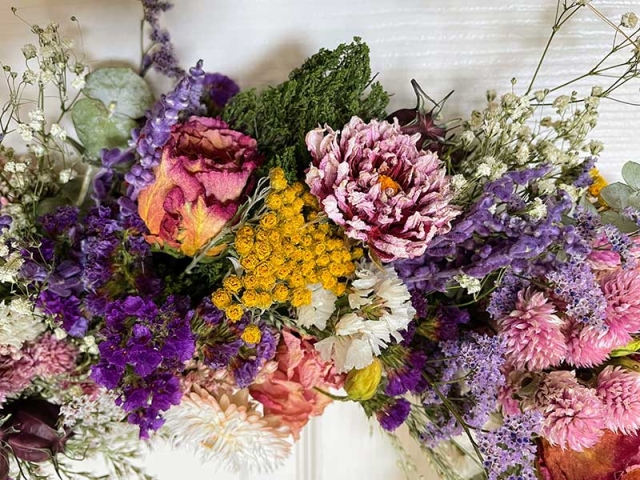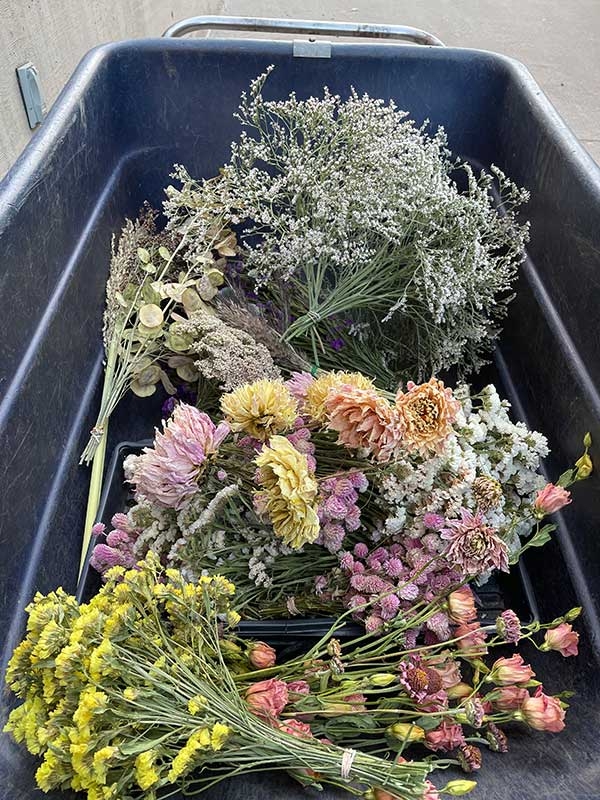The Dried Flower Revival
If dried flowers make you think of withered Miss Havisham and her decaying wedding dress, then it’s time to raise your expectations. Today’s dried flowers are nothing like the faded flowers worn by the jilted bride of Charles Dickens’s “Great Expectations.” They’re boldly combined, lushly textured and even colorful.
So, what’s changed? The floral industry has embraced dried plants as it’s pivoted to become more sustainable. When locally sourced and kept natural (not bleached or dyed), dried flowers have a smaller carbon footprint than fresh flowers that are flown in from overseas, refrigerated and displayed in non-biodegradable floral foam.
This has led to a surge in creativity. Floral artists are pushing the boundaries of display – adding dried flowers to fresh and wiring dried plant material to everything from hair combs to chandeliers. They’re also preserving flowers that were rarely dried before, from peony blooms to Smoke Bush plumes, and combining them in ways that take them beyond ordinary.
Consider the brown fronds of dried leatherleaf fern. Alone they may look ho-hum, but when spiraling around the edge of a wreath filled with Honesty seed heads and Chinese Lantern pods, they create energy. Or the fluffy heads of Pampas grass. By themselves, they could pass as feather dusters, but when wired with dried roses and allium seed heads onto chandeliers, they’re positively ethereal.

This isn’t to say dried plants are overtaking freshly cut ones. Not even close. But they are having a heyday — taking center stage at Chelsea in Bloom and becoming a hot trend in weddings. Brides love them because they can be reused for multiple events, and florists — many of which had weddings cancelled due to COVID – consider them a blessing. Instead of tossing all unused fresh flowers, florists were able to dry some for later use.
So how can home gardeners get in on the dried flower trend? Below are a few of the best plants to grow for dried arrangements. All can be easily air-dried. Harvest in the morning when dew has evaporated. Cut long stems, remove leaves, wrap the ends in rubber bands and hang them upside down in a dark room.
- Dahlia: This lush beauty shrinks down to a papery confection. Select dense blooms in pinks and bright orange and yellow. Cut when blooms are half-way or almost fully open.
- Strawflower: This is an oldy, but for good reason; few flowers compare in durability and vibrancy. Select tall-stemmed varieties and cut them just as flowers open.
- Statice: Indispensable as a filler, statice is best known for its annual form. However, the perennial version is also a must-have, especially German Statice, which has tiny starlike flowers. Cut stems when flowers are fully open.
- Larkspur: This reseeding annual is one you wouldn’t expect to dry well, but it holds its form and color. A favorite to dry is ‘Sublime Dark Blue.’ Cut larkspur as soon as the blooms open on the stalk.
- Rose: Not a surprising one, but still one of the best flowers for drying. Select varieties that have plush petals in pinks and vibrant citrus hues. Cut stems with flower buds and just-opened flowers.
- Winged Everlasting: This annual herb has masses of small white flowers with gold centers. Cut when the highest flower on the stem has just opened and the centers are showing.
- Yarrow: One of the easiest perennials to grow, Yarrow produces dense umbels and sturdy stems. Harvest when all the flowers open.

This article first appeared in the March issue of Life on Capitol Hill.
Add new comment